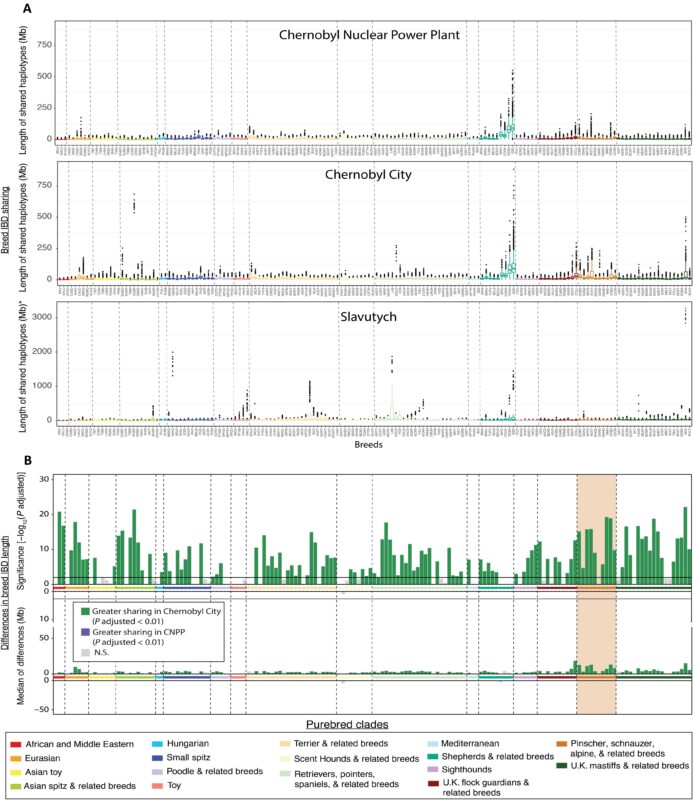In a shocking twist of nature, dogs living near the Chernobyl nuclear disaster site are evolving faster than their counterparts anywhere else in the world. How did these radioactive pups defy the odds and start their own evolutionary revolution? The answer lies in the unexpected consequences of living in one of the most toxic and hazardous places on Earth.
Mutants or Marvels? The Chernobyl Dogs Are Changing Faster Than You Think
The 1986 explosion of the Chernobyl Nuclear Reactor unleashed a catastrophic radioactive disaster that left vast areas of northern Ukraine uninhabitable. Over time, however, a surprising phenomenon emerged in the Chernobyl Exclusion Zone (CEZ): wildlife began to thrive in the absence of humans. Among the survivors are thousands of feral dogs, many of which are descendants of pets abandoned during the hasty evacuation.
A new study has brought attention to these dogs, revealing that their genetic makeup is rapidly diverging from those of their counterparts outside the exclusion zone. “Do they have mutations that they’ve acquired that allow them to live and breed successfully in this region? What challenges do they face and how have they coped genetically?” asked Elaine Ostrander, a dog genomics expert at the National Human Genome Research Institute, in an interview with The New York Times.

The Science Behind the Mutation: What’s Really Happening to Their DNA?
Researchers from the University of South Carolina and the National Human Genome Research Institute are now studying the DNA of 302 feral dogs living in or near the CEZ. Their aim is to understand how radiation might be affecting the dogs’ genetic structure, potentially speeding up their evolutionary development. According to a recent report from Popular Mechanics, the findings are both startling and groundbreaking.
The genetic differences between the dogs near the Chernobyl plant and those just 10 miles (16.09 km) away in Chernobyl city suggest that radiation exposure is having a profound effect. These dogs appear to be experiencing rapid evolutionary changes, with distinct genetic markers that set them apart from their non-radiated counterparts. While the research is still in its early stages, it hints at the possibility that radiation could accelerate evolution in a way we haven’t observed before.

Is Radiation the Secret to Evolution?
You might be wondering: can radiation really trigger such rapid evolution? Surprisingly, yes. Radiation can cause mutations in DNA, leading to faster evolutionary changes. The concept that radiation might spur natural selection is not new. For years, scientists have used controlled radiation exposure in experiments to induce beneficial mutations in plants and animals.
The dogs living in Chernobyl may be experiencing a similar phenomenon, where radiation exposure is accelerating their evolution. This is not just a matter of surviving the harsh conditions; these dogs may be evolving faster than dogs in other parts of the world, potentially giving rise to new traits or even a new breed of dog entirely.
Ostrander explains the significance: “What challenges do they face and how have they coped genetically?” Their genetic shifts could be the result of mutations that help them survive the radiation, a process scientists are just beginning to explore.
From Frogs to Dogs: A Surprising Pattern of Evolution in Chernobyl
It’s not just dogs that are undergoing genetic transformations in Chernobyl. Other species, including frogs and birds, are also exhibiting signs of rapid evolution. For instance, tree frogs in the area, typically green, are showing darker pigmentation. Researchers believe this adaptation is likely a result of a mutation in melanin, which helps the frogs manage radiation exposure.
This brings up the fascinating possibility that the radiation affecting all species in the area could be speeding up the evolutionary process. While the Chernobyl dogs’ transformation is a primary focus, scientists are exploring whether other animals are undergoing similar shifts. With less human interference, the CEZ is evolving into a natural laboratory for studying rapid genetic changes.
The Evolutionary Time Bomb: What Does This Mean for the Future?
As we approach the 40th anniversary of the Chernobyl disaster, it’s clear that the area is far from the lifeless wasteland it was once thought to be. Instead, it has become a hotspot for rapid evolutionary changes that could reshape the future of these animals. The Chernobyl dogs, in particular, are at the center of a groundbreaking study that challenges our understanding of evolution in the face of extreme conditions.
The big question remains: what will become of these dogs? Will they evolve into a completely new species, or is this just a short-term genetic adaptation? Only time—and further research—will tell.
One thing is certain: the Chernobyl dogs are living proof that radiation, once seen as purely destructive, can also play a role in the process of natural evolution. Whether mutants or marvels of survival, these dogs are part of a new chapter in the story of life’s adaptability in the most extreme environments.
The study was originally published in the journal Science Advances.
This post was originally published on this site be sure to check out more of their content.













































